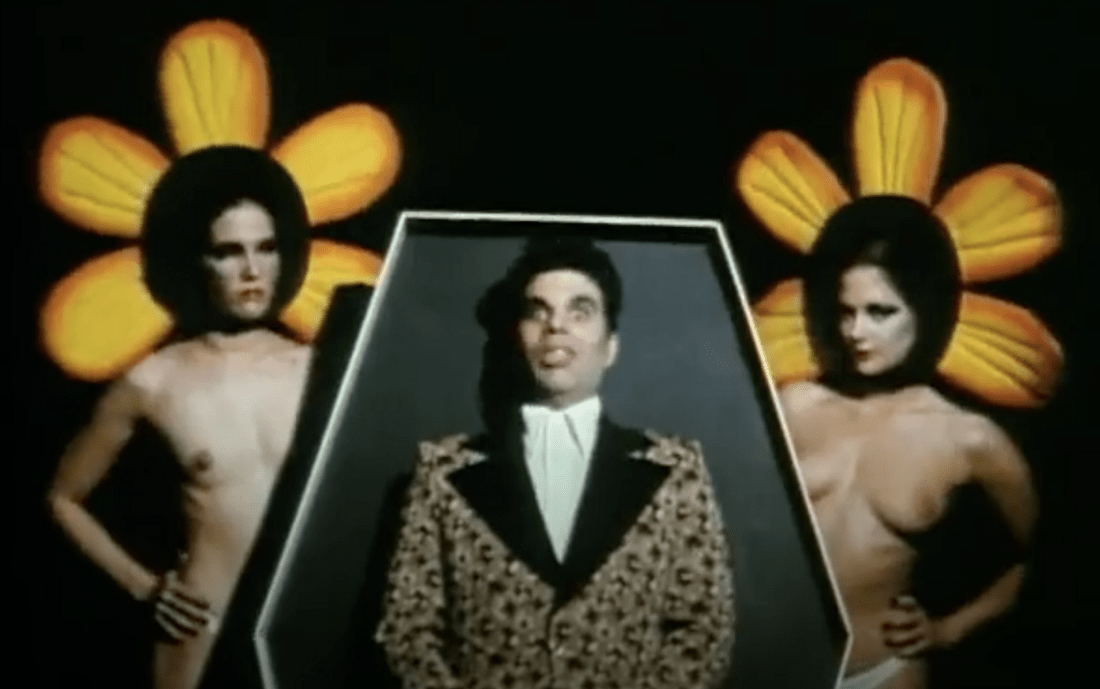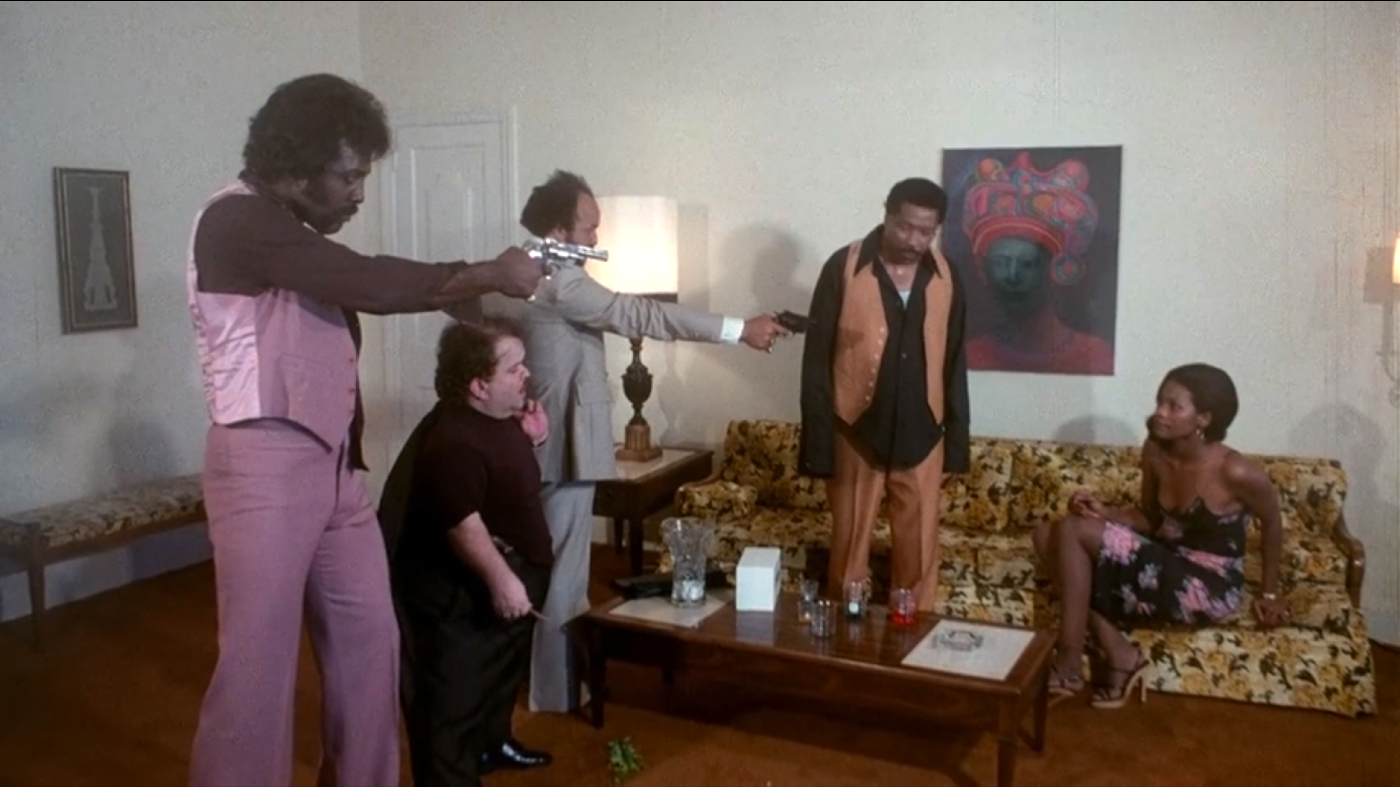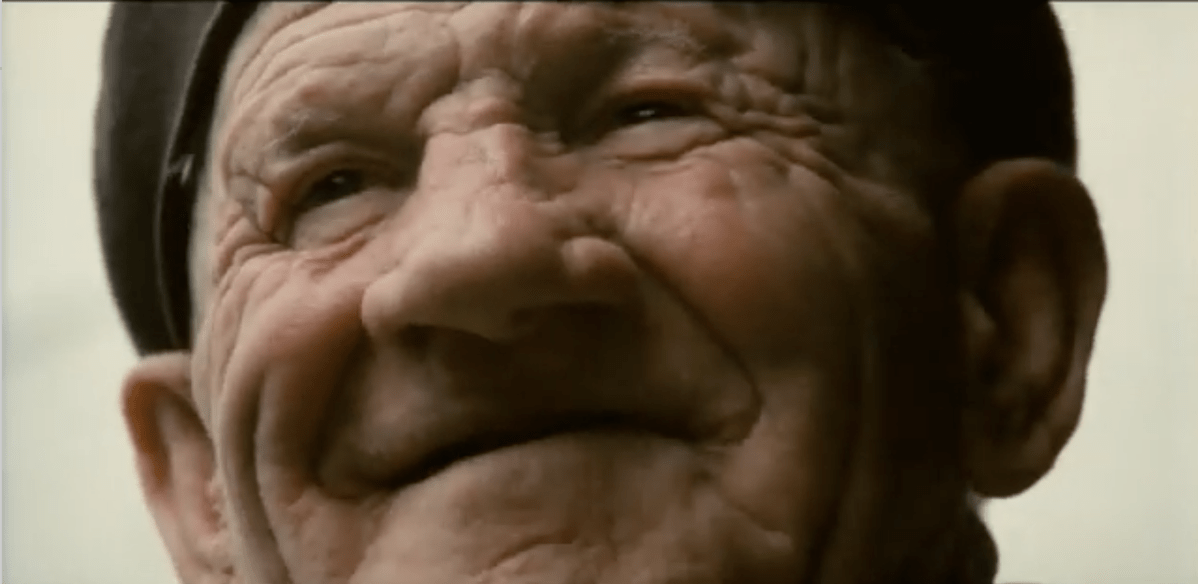
Three Outlaw Samurai was director Hideo Gosha’s first film. He made it in 1964 and with its release he began a lauded career in the chanbara genre. From the beginning of the film you can see that Gosha was influenced by the chanbara directors who came before him. Kurosawa had helped to establish and shape the genre, populating it with larger-than-life samurai struggling in larger-than-life duels. Gosha begins with one foot firmly planted in Kurosawa’s camp but then leans into something darker.
Both Gosha and Kurosawa foreshadowed a character’s personality and their fate by the way they were introduced into a film. A character’s role and development were a direct result of their opening scene. This is particularly evident in Three Outlaw Samurai.
The film begins with Shiba, the main character, scavenging a piece of cloth from a roadside shrine to fix his worn out sandals. Once he repairs them he trudges off through the mud. He may have a fancy sword and a topknot but his feet are as muddy as the next person’s. He is willing to eschew the higher morals represented by the shrine if practical matters necessitate it. He is a well grounded individual, a realist, who is not afraid to get his hands (feet) dirty.

Both directors recognize the inherent contradictions in the life of the samurai. Samurai enjoyed an elevated social status but without a shogun or daimyo to serve they could easily end up as desperate and poor as any peasant. They demanded respect but like Shiba they were often knee deep in the muck right next to everyone else.
In chanbara samurai are often depicted as having an uneasy and ill-defined relationship to the class system. Their status was unstable which bred a kind of resentment or contempt for society’s structure. Samurai did not trust the motivations of the people who surrounded them and often they assumed the worst. In Three Outlaw Samurai and in many chanbara a samurai’s most salient feature was his ability to coldly assess a person’s character. The samurai could see through the honorable facades that people so meticulously maintain and get directly to the heart of who people were and what they wanted. The samurai was trained to accurately evaluate their opponent and in the chaotic world of Edo era Japan that could be anyone.
There is almost a noir quality to films like Three Outlaw Samurai in that life is seen as a rough and dirty game. At the heart of the film are three samurai who each have their own way of playing that game and their own sense of what the rules are.

Shiba is the first to appear on screen. He is the most noble, but even he begins the film as a cold and dismissive amoral observer who hangs out with the troubled peasants just to see what happens. He makes clear he is not there to help, but that he will stick around just to see how things turn out. He plays as if he is just there for the entertainment value, but when he recognizes that the situation is serious he renounces his neutrality and pledges to help, as foreshadowed by his muddy footed introduction.

The second samurai is Sakura. He is a simple man who grew up in the countryside. He, like many samurai, has been reduced to making a living as a mercenary. We first encounter him in a prison cell where he is very comfortably sleeping. When roused and given an assignment he is reluctant to leave his free room and board even if it is in a prison. The fact that we first meet him in prison puts his morality in question, and the swagger and defiance in the face of authority hints at his courage. His willingness to stay incarcerated highlights his pragmatism.
He is eventually offered enough money to go fight Shiba but pragmatism or no, as soon as he meets Shiba and the peasants Shiba is defending, Sakura sees their nobility and switches to Shiba’s side. Even if Sakura’s sense of honor doesn’t fit society’s model he does in fact have a moral code and it leads him to abandon the easy route and take up arms in a dangerous but noble cause.
The peasants are fighting against the local magistrate who is taxing them into starvation. They have kidnapped the magistrates daughter and are hoping to use her as a bargaining chip. The samurai don’t necessarily approve of this strategy, in fact they can see that it has made a terrible mess, but they are willing to enter the fray despite the disadvantaged position they will inherit.

The last of the three samurai is Kikyo who works for the magistrate and is almost completely amoral. He is solely motivated by carefully calculated self interest. He doesn’t seem to care about anyone or anything but if someone’s goals align with his he will provide his services. He is not swayed by the peasants’ cause at all. He is a taciturn man and so his motivations are never fully revealed but it is clear that he admires Shiba and eventually he assists him.

Shiba, Sakura and Kikyo all have complex and fluid motivations that are not always reliable. There is the sense that at any moment any of the samurai may decide to cut their losses and leave. We can see that their inner morality is strong but we can not always predict how it will guide them.
Throughout its history the chanbara genre has been influenced by American style westerns. Seen through this lens Three Outlaw Samurai is a strange combination of John Ford and Sergio Leone. It has the moralism and social commentary of a Ford film which elevates the struggle of the humble farmer into a noble calling. For Ford farmers are the keepers of the true and simple ways of old. They live by a code where each man gets his just reward for a hard day’s labor. Their earnest ways are contrasted against the greedy cattle ranchers or railroad barons who want to plunder the land with no regard for what is good or true.

In chanbara there is the same concern for the old ways but it is made more complicated by adding a concern about the rigidity of the class system. The old ways may be righteous but they drag with them unwanted and oppressive feudal traditions. For Ford it is the humble and honest poor against the haughty and corrupt rich but for Gosha it is a more intractable tangle between individuals who must forge a new morality and a new way of life amidst a changing society.
In both the American Western and the Japanese chanbara, the the gunslinger or samurai is there to not only protect the farmers but to preserve the farmer’s purity. The farmer’s hands are meant to be stained with mud, not with blood. It is the gunslinger or the samurai who will do the necessary dirty work of defending what is right. He will pay the mental and spiritual price for the sin of violence, instead of the farmers. Shiba even volunteers to suffer 100 lashes to spare a farmer for whom the punishment was intended.
All of this fits the Ford model of how a western works but then Three Outlaw Samurai is muddied by a second layer that predates but is none the less very much like the westerns of Sergio Leone. For Leone no one is pure, no one is spared. The violence is more random and cruel. People do not necessarily get what they deserve, and all is not necessarily well in the end.
The peasants in Three Outlaw Samurai are fighting for a good cause but they are reckless, frightened and often foolish. Their mistakes not only cause trouble for them but for everyone. It is similar to the role of the prostitutes in Clint Eastwood’s Unforgiven. They have been wronged and they have a right to justice but the way they seek justice causes more harm than good.
Just this next paragraph contains spoilers
In the end of Three Outlaw Samurai the peasants are not vindicated. They fall victim to cowardice making all the bloody struggles of the samurai meaningless and moot. Three Outlaw Samurai may begin like Kurosawa’s Seven Samurai but it does not end that way. In Three Outlaw Samurai the characters simply disperse leaving behind a world no better than it was before.
The musical score in Three Outlaw Samurai is typical for the genre and for many Japanese films. In Japan scores are often less melodic and based more on clusters of sound. Individual instruments like the shakuhachi flute or the taiko drum are used almost as sound effects or punctuations. It is a unique way of augmenting the scene without hijacking it. Music is such a powerful addition to a scene it can easily overwhelm the subtleties or nuances of what is happening. Sweeping orchestras, tense violins, and melancholy cellos are all very effective but it can feel like painting with a very broad brush where a thinner more exact gesture might work better.
The opening of Three Outlaw Samurai begins with these small clusters of one or two instruments popping in and out, but when the title screen appears there is a completely over-the-top blast of sound as if the world is about to end. It’s comical, but then the film settles back into the subtly integrated music that underlines and highlights certain moments or feelings. It must be an inheritance from noh and kabuki where just some simple clacking on a hyōshigi woodblock or a pluck of a koto string is enough to augment the atmosphere.
The fight choreography in chanbara varies wildly. Although Sword of Doom is a wonderful film it makes little effort to simulate anything believable when it comes to the actual sword fights. The sword play in Three Outlaw Samurai is much more compelling. It’s not necessarily “realistic” but it is fast and hard. It is dramatic and stylized particularly when the final blow is made. Here again we see the inheritance of Kurosawa. The end of every fight is the same. The winner makes some large, grand swipe or stab and then both perpetrator and victim freeze in a moment of tableaux. Then the victim slowly falls to the ground like a rigid sculpture falling from its pedestal.

Three Outlaw Samurai also includes blood which is a line some chanbara do not cross. The graphic depiction of blood spurting or dripping from a wound is more Leone than Ford. It drives home the brutality of even “justified” violence. It’s not just about drama or even realism, it is an indicator of the gravity and cruelty of murder which tests the audience’s ability to justify what the hero is doing. It’s one thing to want to see the bad guy dead, it’s another to watch him die.

Three Outlaw Samurai moves along several axes. It is a macho martial arts contest, it’s a treatise on morality and pragmatism, it’s a social commentary about the class system, and it’s a period drama. Japan’s anxieties about moving into the modern age can be seen throughout many of its twentieth century films. Whether it is the generational divides in Ozu’s films, the destructive Kaiju in Honda’s, there was a deep concern for the loss of Japan’s identity and traditions.
The noble samurai were once the pinnacle of honor and sacrifice. They followed the code of bushido (the way of the warrior) and would lay down their lives for what was right. Through storytellers like Gosha this image was problematized. As Japan witnessed its own transformation from feudalism to capitalism it gazed backward into its past to evaluate what was being changed and what was being lost. Leaving behind the rigid inequality of feudalism may have been a welcome change but could shogunates, samurai, and peasants be left behind without stripping away everything else? If the Empire of Japan became a democracy and embraced capitalism would avarice replace honor?
Gosha would go on to make many more chanbara such as Sword of the Beast (1965), Goyokin (1969) and Hitokiri (1969). Like many chanbara directors Gosha’s filmography is very long. If you merge his catalogue with directors like Kihachi Okamoto, Hiroshi Inagaki, Kenji Misumi, and Kihachi Okamoto you are assured a lifetime’s worth of viewing.

If you enjoyed this article you might also enjoy this - https://filmofileshideout.com/archives/favorite-scenes-%e2%84%962-rashomon/



